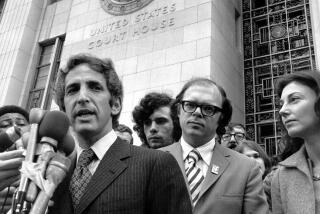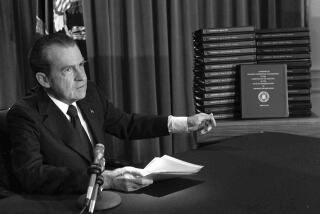Why Watergate matters
- Share via
TODAY MARKS the 35th anniversary of one of the most famous and most misunderstood events in modern American history: the break-in at the Democratic National Committee’s headquarters in the Watergate office building on June 17, 1972. The break-in set off a chain of events known as “Watergate,” which led ultimately to Richard Nixon’s forced resignation as president — and which is also misunderstood. For history’s sake, it’s important to set these things straight.
The break-in became famous, of course, because the inept burglars got caught by the night watchman — did they not expect that there would be one? — who called the police, who in turn called in the FBI and federal prosecutors. But it was in fact the fourth attempt by the burglars and their supervisors, E. Howard Hunt and G. Gordon Liddy — collectively known as the “plumbers” — to get into the DNC offices and, among other things, place a tap on the telephone of the party chairman, Lawrence O’Brien.
The plumbers got their label because they had originally been hired by the Nixon White House to plug leaks to the press; Nixon had been particularly enraged by Daniel Ellsberg’s 1971 leak of the Pentagon Papers, a study of the Johnson administration’s conduct of the Vietnam War. (Nixon feared that the study would reflect badly on his own handling of the war, and besides, he hated leaks.)
The first attempted break-in failed because the conspirators got locked in a closet off the main dining room of the Watergate complex. The next one didn’t work because the burglars — most of them Cubans and veterans of President Kennedy’s failed invasion of the Bay of Pigs — couldn’t figure out how to pick the lock on the committee’s door. After that, one of the burglars returned home to Miami to collect better equipment.
During the Memorial Day weekend of 1972, the burglars first succeeded in entering the party headquarters, where they photographed documents and placed taps on the phones of O’Brien and another committee aide. But the tap on O’Brien’s phone wasn’t placed correctly, and John Mitchell, the former attorney general who was head of Nixon’s reelection committee, told Liddy to go back and fix the tap. Liddy readily agreed; by this time, it was no big deal.
The plumbers were almost comically inept in this and other operations, including a raid the previous year on the Beverly Hills office of Dr. Lewis Fielding, Ellsberg’s psychiatrist. They had broken in to seize the file on Ellsberg, but when they got there, they found no files at all.
But their bungling did not make what they were about any less sinister.
Watergate was not merely an event, or even a series of events, but a mentality that permeated Nixon’s presidency from the beginning. Within a month after he was sworn in in 1969, Nixon instructed his aides to set up a secret office, paid for by private (and therefore illegal) funds, to “get the goods,” as he put it, on his perceived enemies. The first assignment for these White House-hired gumshoes was to tail Sen. Edward M. Kennedy of Massachusetts, who Nixon thought might be his Democratic opponent for reelection.
Think of it: an American president considering political opponents and other domestic critics — hardly people armed with nuclear weapons — his “enemies.” And then using the instruments of government, such as the Internal Revenue Service, against them. (“Crush them” was another oft-used Nixon phrase.) Nothing like this is known to have happened at any other time in U.S. history.
The break-in at the DNC and other actions (such as the hiring of Donald Segretti to disrupt and create chaos at Democratic Party events) portray a president intent on undermining and even interfering with the opposition party’s nominating process. In that sense, the Nixon operation was like a step on the road to fascism. The first thing a usurper does is undermine the opposition party.
Watergate was not, as some Nixon defenders still argue heatedly, a “mere” burglary and coverup. It was a constitutional crisis. The raid on Ellsberg’s psychiatrist’s office was a clear violation of the 4th Amendment’s prohibition against unwarranted searches and seizures. And Nixon was engaged in a systematic attempt to defy the courts and Congress — denying them information and seeking to make the executive branch unaccountable to the other branches of government.
At stake was whether our system of government would successfully withstand Nixon’s abuse of power. It’s become a settled part of history that “the system worked.” But it almost didn’t. Many members of Congress were loath to move against Nixon until they found a “smoking gun” — in a roomful of smoke.
But even before the smoking gun was found — a tape on which Nixon instructed his top aide, H.R. (Bob) Haldeman, to tell the CIA to tell the FBI to drop the Watergate case, on the (nonexistent) ground of a threat to national security — the House Judiciary Committee had decided on bipartisan votes that Nixon had committed impeachable offenses.
The committee’s deliberations were serious and careful. This was no partisan lynch mob out to “get” Nixon; his fate was sealed not by the “liberal media,” as Nixon die-hards said and still say, but by a thoughtful group of members of Congress of both parties, as well as the office of the independent counsel, which Nixon had been forced to appoint. In the end, it was a small group of Republican congressional leaders who went to the White House and told Nixon that he had to resign.
All of this matters not only because it’s an important part of American history but because it is a cautionary tale about overreaching for power, abuse of the office of the presidency, and about protecting the Constitution. Such things matter a lot.
More to Read
Get the L.A. Times Politics newsletter
Deeply reported insights into legislation, politics and policy from Sacramento, Washington and beyond. In your inbox three times per week.
You may occasionally receive promotional content from the Los Angeles Times.










